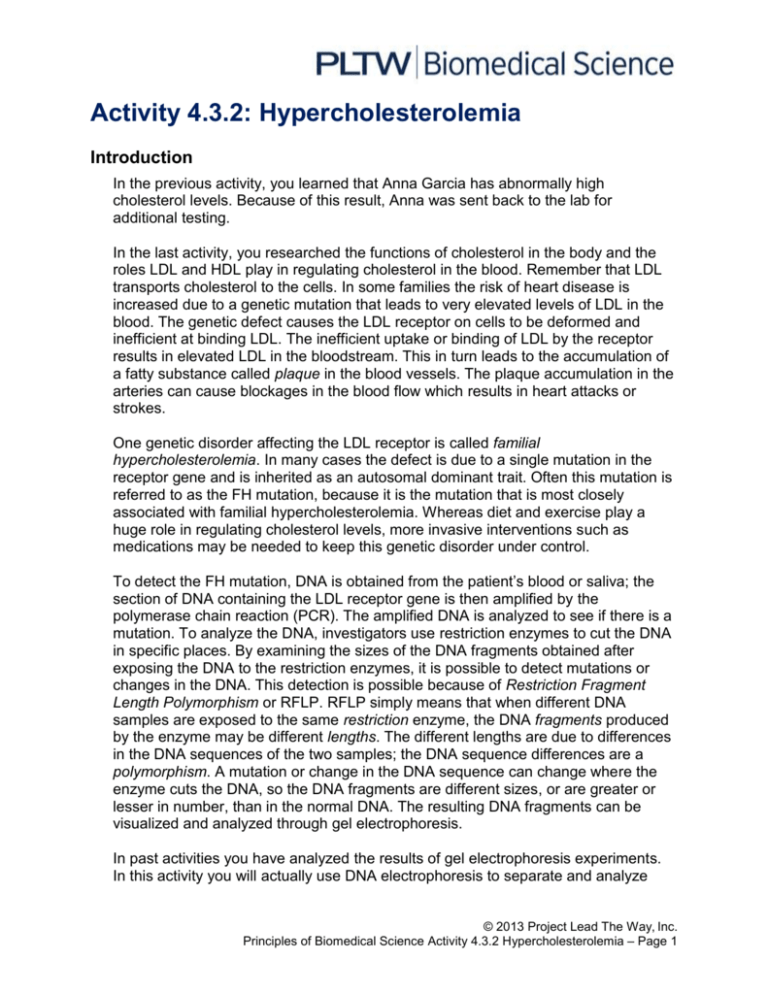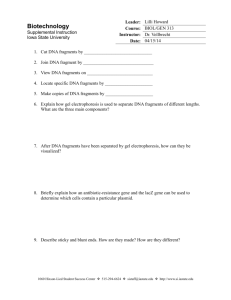A4.3.2.HypercholesteremiaF
advertisement

Activity 4.3.2: Hypercholesterolemia Introduction In the previous activity, you learned that Anna Garcia has abnormally high cholesterol levels. Because of this result, Anna was sent back to the lab for additional testing. In the last activity, you researched the functions of cholesterol in the body and the roles LDL and HDL play in regulating cholesterol in the blood. Remember that LDL transports cholesterol to the cells. In some families the risk of heart disease is increased due to a genetic mutation that leads to very elevated levels of LDL in the blood. The genetic defect causes the LDL receptor on cells to be deformed and inefficient at binding LDL. The inefficient uptake or binding of LDL by the receptor results in elevated LDL in the bloodstream. This in turn leads to the accumulation of a fatty substance called plaque in the blood vessels. The plaque accumulation in the arteries can cause blockages in the blood flow which results in heart attacks or strokes. One genetic disorder affecting the LDL receptor is called familial hypercholesterolemia. In many cases the defect is due to a single mutation in the receptor gene and is inherited as an autosomal dominant trait. Often this mutation is referred to as the FH mutation, because it is the mutation that is most closely associated with familial hypercholesterolemia. Whereas diet and exercise play a huge role in regulating cholesterol levels, more invasive interventions such as medications may be needed to keep this genetic disorder under control. To detect the FH mutation, DNA is obtained from the patient’s blood or saliva; the section of DNA containing the LDL receptor gene is then amplified by the polymerase chain reaction (PCR). The amplified DNA is analyzed to see if there is a mutation. To analyze the DNA, investigators use restriction enzymes to cut the DNA in specific places. By examining the sizes of the DNA fragments obtained after exposing the DNA to the restriction enzymes, it is possible to detect mutations or changes in the DNA. This detection is possible because of Restriction Fragment Length Polymorphism or RFLP. RFLP simply means that when different DNA samples are exposed to the same restriction enzyme, the DNA fragments produced by the enzyme may be different lengths. The different lengths are due to differences in the DNA sequences of the two samples; the DNA sequence differences are a polymorphism. A mutation or change in the DNA sequence can change where the enzyme cuts the DNA, so the DNA fragments are different sizes, or are greater or lesser in number, than in the normal DNA. The resulting DNA fragments can be visualized and analyzed through gel electrophoresis. In past activities you have analyzed the results of gel electrophoresis experiments. In this activity you will actually use DNA electrophoresis to separate and analyze © 2013 Project Lead The Way, Inc. Principles of Biomedical Science Activity 4.3.2 Hypercholesterolemia – Page 1 DNA fragments. Use your final gel to determine if Anna and members of her family have familial hypercholesterolemia. Equipment Computer with Internet access Laboratory journal PBS Course File Career journal Career Journal Guidelines Documentation Protocol Edvotek Cholesterol Diagnostics Kit o Three DNA samples o Methylene Blue DNA dye o Practice loading dye One agarose gel (1% or 0.8% agarose) Agarose gel to use for practice loading sample Tris-Borate-EDTA (TBE) gel electrophoresis buffer Gel electrophoresis apparatus Micropipettor (20 - 100 L) Disposable micropipette tips Light box Latex or nitrile exam gloves Activity 3.4.1 Pedigree Resource Sheet Project 4.3.1 Medical History Resource Sheet Procedure 1. Review materials from Unit 3 to refresh your memory on the inheritance of dominant and recessive disorders. Remember that FH is an autosomal dominant disorder. The mutation is carried on chromosome 19 (one of the 22 pairs of autosomes, or non-sex chromosomes), and a person needs to only inherit one affected copy to have the disorder. 2. Draw a Punnett square below that illustrates the likelihood that a man with FH and a woman who is unaffected would have a child with FH. Show and explain your work. Use the letter “F” to designate your alleles. 3. Watch the animation called DNA Restriction on the Dolan DNA Learning Center website at: http://www.dnalc.org/ddnalc/resources/restriction.html to review how restriction enzymes cut DNA and how DNA electrophoresis is performed. 4. Prepare a 1% or 0.8% agarose gel as directed by your teacher. This step may have been completed for you. © 2013 Project Lead The Way, Inc. Principles of Biomedical Science Activity 4.3.2 Hypercholesterolemia – Page 2 5. Place the agarose gel into the gel electrophoresis apparatus and pour TBE until the gel is submerged with the buffer approximately 5 mm over the top of the gel. 6. Place a pipette tip securely onto the micropipettor. 7. Read the instructions on using a micropipettor posted on the Davidson College, Department of Biology website by Dr. A. Malcolm Campbell http://www.bio.davidson.edu/COURSES/Molbio/Protocols/pipette.html 8. Practice using the micropipettor to pick up 35 L of practice loading dye. To get a feel for the plunger and how the micropipettor works, simply pick up the fluid into the pipette tip and expel the liquid right back into the tube. 9. Practice loading 35 L samples into a gel by loading 35 L of the practice loading dye into the practice agarose gel. Be careful to keep the plunger depressed until after you have raised the micropipettor away from the gel. Otherwise, you risk removing the sample from the well by drawing it back into the pipette tip. Repeat until you are confident in your skill and can consistently draw up 35 L and place it into a well in the practice gel. 10. Reference Anna Garcia’s family tree shown below. Some members of Anna’s family were available for testing; others were not. Once you have run your gel, you will determine the genotype of each individual tested and deduce the genotype of those who were not tested. 11. Note that you will load the following samples into your gel. DNA Standard Markers Normal DNA Sample FH control (FF) Patient #1 – Carlos (Anna’s father) Patient #2 – Anna Garcia Patient #3 – Eric (Anna’s brother) Patient #4 - Jason (Anna’s brother-in-law) Patient #5 – Erin (Anna’s niece, Jason and Juanita’s daughter) © 2013 Project Lead The Way, Inc. Principles of Biomedical Science Activity 4.3.2 Hypercholesterolemia – Page 3 12. Load 35 L of each of the patients’ samples into separate wells of the agarose gel. Make sure you know which sample is in which well. 13. Draw a diagram of the gel in your laboratory journal and label the contents of each well. 14. Follow the teacher’s instructions to assemble the gel electrophoresis apparatus and connect the power supply. Be sure to check the polarity of the apparatus; the DNA containing wells should be closer to the negative pole and farther from the positive pole. 15. Follow the teacher’s instructions to turn on the power supply. 16. Check the DNA samples 5 minutes after turning the power supply on. Make sure the DNA is migrating out of the well and that it is moving in the direction where it has the most distance to move. It will take several minutes for the DNA fragments to separate in the gel. 17. Check your DNA samples every 10 minutes and turn off the power supply when the dye is near the bottom edge of the gel. Be careful not to allow the dye to run off the edge of the gel. 18. While the gel runs, view the DNAi animation which explains how DNA moves through the gel available at http://www.dnai.org/b/index.html. Select techniques, then sorting and sequencing, and finally gel electrophoresis. 19. Take notes on the animation in your laboratory journal so you can explain how DNA electrophoresis sorts differently sized fragments of DNA. 20. When the gel run is complete, follow your teacher’s instructions to stain and visualize the DNA fragments. 21. Examine the DNA fragments. Sketch your finished gel with the stained DNA fragments in the Genetic Analysis section of the Project 4.3.1 Medical History Resource Sheet. Clearly label each lane. 22. Analyze the pattern of restriction fragments from the three patients to determine whether the patient is homozygous normal for the LDL receptor (ff), homozygous for the defective LDL receptor (FH mutation) (FF), or is heterozygous for the defective LDL receptor (Ff). The normal gene produces a single fragment when exposed to the restriction enzyme. The FH mutation introduces a new reaction site for the enzyme so that two fragments are produced. Refer to the control lanes on your gel for guidance. 23. Write the genotype of each individual beside their name on your sketch. 24. Draw a pedigree for familial hypercholesteremia in Anna’s family under the gel picture on your Project 4.3.1 Medical History Resource Sheet. Use the blank family tree provided in Step 10 as a start. Refer the Activity 3.4.1 Pedigree resource sheet if needed to add proper shading. Provide a key for the pedigree. 25. Deduce the genotype of those individuals who were not tested. You may need to use Punnett squares to show your logic. Begin by working backwards to determine Maria’s genotype. Add her information to the pedigree. Use this new information to help you deduce Juanita’s genotype. Add this information to the pedigree. © 2013 Project Lead The Way, Inc. Principles of Biomedical Science Activity 4.3.2 Hypercholesterolemia – Page 4 26. Complete additional research on familial hypercholesterolemia if needed to describe the disorder and the associated treatment. Add additional recommendations to the Recommendations section of the Project 4.3.1 Medical History Resource Sheet. 27. Return to the Activity 4.1.2 Autopsy Report. Note that evidence of a statin was found in Anna’s bloodstream. Research how this medication is linked to cholesterol control. 28. Follow the Career Journal Guidelines and complete an entry in your Career Journal for a molecular biologist. Be sure to describe how this professional could play a role in the diagnosis or treatment of disease. 29. Follow the PLTW Biomedical Sciences Documentation Protocol to correctly document or cite the sources of information you used. 30. Answer the remaining Conclusion questions. Conclusion 1. Explain how you could determine which individuals were heterozygous by looking at the gel. 2. Explain how you determined the genotype of Maria and Juanita, even though you did not test their DNA. 3. Explain how the use of Restriction Fragment Length Polymorphisms to diagnosis genetic disease differs from its use in forensic investigations. © 2013 Project Lead The Way, Inc. Principles of Biomedical Science Activity 4.3.2 Hypercholesterolemia – Page 5 4. Why did the DNA migrate to the positive pole of the electrophoresis chamber? In your response, discuss the chemical structure of DNA. 5. Erin is only 17 years old and her total cholesterol is 600 mg/dL. Why do you think her cholesterol is so much higher than the others in her family who have familial hypercholesterolemia? 6. Explain how the class of medications called statins works to lower cholesterol levels in the body. © 2013 Project Lead The Way, Inc. Principles of Biomedical Science Activity 4.3.2 Hypercholesterolemia – Page 6






![Student Objectives [PA Standards]](http://s3.studylib.net/store/data/006630549_1-750e3ff6182968404793bd7a6bb8de86-300x300.png)
